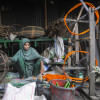Within a few days, I will head out to search for "shola". The shola plant thrives in areas with abundant water like marshes, ponds, and riverbanks. But if there are not enough wetlands, there won't be any shola. I've seen many beels and canals disappear. Yet, in some parts, like Jashore and Faridpur, you may still find them. I fear that within five or six years, we won't find enough shola plants to continue this craft.
For over half a century, Gopendra Nath Chakraborty, a 75-year-old craftsperson, has been shaping the delicate beauty of shola. His hands, aged with the wisdom of years, have crafted thousands of pieces, each an example of his patience, skill, and love for an art that is slowly dying.
As Chakraborty searches for the plant that has shaped his livelihood, he knows that his craft is at risk, not because of his age, but because the very material he uses is becoming harder to find.
What is shola?
Soft and spongy, shola comes from the stem of the Aeschynomene aspera plant, often referred to as "Indian cork." It thrives in waterlogged regions like Bangladesh, Assam and Odisha of India — particularly in marshes, riverbanks, and ponds.
When peeled and dried, the inner pith of the shola plant reveals a pristine white surface, perfect for crafting. Artisans shape this into everything from life-like flowers to intricate religious ornaments.
Shola crafts are an integral part of some of life's biggest moments – whether it's the headpieces worn during Hindu weddings or the ornaments that adorn the idols during Durga Puja. Yet, despite its beauty and significance, this age-old craft is slowly slipping away.
Legacy of the craft
Artisan Mintu Ray started his career in Old Dhaka and he shares how deeply personal this craft is to him.
"I lost my parents when I was very young, so unlike other artisans, I didn't inherit the skills of shola craftsmanship. I started it merely as a hobby and now, I have numerous artisans who work with me. They are my family. I've been making shola crafts for almost two decades now, whether it's a peacock or a hilsa fish, you name it and I'll create it for you," Ray says with confidence.
Like Gopendra Chakraborty, Ray also sees the challenges the craft faces.
"People used to buy shola toys for their children but now we only see demand during religious festivals like Durga, Kali, and Lakshmi pujas. The year-round demand mostly comes from Hindu weddings, where traditional items like shola garlands and headpieces are still cherished," he says.
In recent years, shola crafts have been exported to Kolkata, where they remain in high demand. Unfortunately, in our country, the craft has yet to receive the recognition it deserves.
In recent years, the market for shola crafts has become increasingly seasonal, with most of the demand concentrated around major religious festivals and wedding seasons. While artisans like Ray have managed to continue their work by exporting to Kolkata, where shola remains highly valued, the local market in Bangladesh has not been as receptive.

A new generation of artisans
Despite the challenges, a new generation of artisans is working to keep the tradition of shola alive.
Shahamsha, an artist and event planner, is one such individual. He believes that the future of the craft lies in adapting to modern needs while preserving its cultural roots.
"I am an artist and have been working with shola for 16 years. Presently, I have an event planning group, which mostly consists of artists from the Fine Arts Institute of Dhaka University," he says.
Shahamsha's group creates shola crafts for special occasions like Pahela Baishakh and Victory Day, and they also take on contracts for weddings.
"The demand for shola hasn't dwindled completely – if it had, I would not have been able to run my group. I believe this craft needs nurturing, and it largely depends on the younger generation to carry the legacy of shola forward," he adds.
Shahamsha's optimism is a reminder that while the challenges facing shola artisans are real, there is still hope.
As more people become aware of the environmental benefits of using natural, biodegradable materials like shola, there is potential for a revival of interest in this traditional craft. The key to preserving it lies in finding a balance between honouring the cultural heritage and reimagining its use in modern contexts.
That said, shola, at its core, is also an eco-friendly alternative to the mass-produced, synthetic materials that have flooded the market in recent years. As consumers increasingly seek out sustainable products, shola's biodegradable nature presents an opportunity to position it as a symbol of mindful, artisanal living.
Yet, to truly preserve the craft, there must be a concerted effort to protect the wetlands that support the growth of the shola plant. Without these natural resources, artisans will have nothing to work with and a key piece of the country's cultural heritage will be lost forever.













Comments